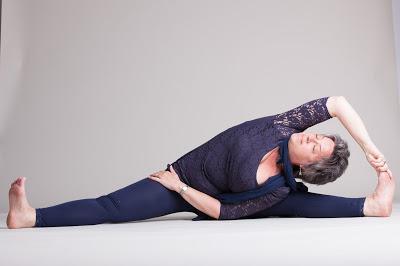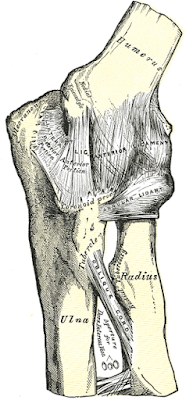
Wendy Sandsjo, Age 55, Adaptive Yoga Scandinavia
We have written a lot on the blog about improving and maintaining good physical flexibility (see Yoga and Flexibility: An Overview) but have not really provided a basic definition of what it is to start with. After almost four years of blogging, it’s about time, don’t you think?I had my own ideas about what flexibility is, but I decided to see how experts in sports medicine and exercise physiology define it. My favorite definition is from the Dictionary of Sport and Exercise Science and Medicine:
“Flexibility is the range of movement around a joint; dependent on a number of factors, including the size and shape of the bones, the ability of tendons to stretch, the condition of the ligaments, normal joint mechanics, soft tissue mobility and extensibility of the muscles.”
To this list of factors, I’d add age, history of injuries, and health conditions that could limit or enhance flexibility, such as arthritis or Ehler-Danlos Syndrome.
Now let’s look more closely some of these aspects of flexibility to get a better understanding of flexibility. (Is flexibility more complex than you originally thought?)
Size and Shape of Bones
The things we are moving around when we do are poses are our bones. Our definition of flexibility mentions that the size and shape of those bones affects flexibility. If we compare the flexibility of two different joints, say the elbow joint and the vertebral joint between thoracic vertebra 6 and 7, we notice a distinct difference in the range of motion or movement at those joints for which the size and shape of the bones is responsible. (The range of motion refers to the angular degree that two bones bend around one another in the movements we call flexion, extension, side-bending, and rotation.) Let’s start with the elbow joint.

Now let’s compare that to the smaller, rounder, flatter thoracic bones of T6 and 7.

Thoracic Spine in Blue and Yellow
These bones have three places where they make contact and a spongy disc in between them that contributes to their ability to pivot over one another to a bit. They can flex, extend, side-bend and rotate over one another, but to much smaller ranges of motion compared to the elbow, except that they can side-bend while the elbow cannot. Even though the movement at this one joint is not large, when you add the same movements of all the spinal bones above and below it together, the spine can move in all directions to a larger degree and is quite “flexible”!Tendons
Tendons are a tougher tissue called “connective tissue” (because they connect things together!)—which are really continuations of another important connective tissue called “fascia” (more on that below)—that thicken and narrow at the two ends of muscles to attach the muscle to the bones. A tendon is inherently less stretchy then a muscle, so we really don’t want to try and stretch tendons to improve our flexibility. When we do, we risk tearing the tendons, which can result in tendonitis or inflammation of the tendon—painful! Ligaments are made of similar stuff as tendons, and they keep two neighboring bones close together and provide some stability for the joint, and at the same time allow for a certain “passive” range of movement at the joint. If I asked you to completely relax your arm muscles and allow me to move your elbow joint through its range of motion, the ligaments would contribute to how far I can take you in each direction to a large degree. We also don’t want to actively stretch the ligaments, because, like the tendons, this usually results in tearing them and injuring the joint and negatively affecting flexibility.
Joint Mechanics
Normal joint mechanics are unique in each joint and have evolved over time to allow certain movements to take place at those joints. But some consistent factors influence the mechanics of the joints: the shape of the bones, the coating of cartilage between the bones, the tough connective tissue sleeve called the joint capsule around the mobile joints, the slick oil-like fluid in the joints, the number of ligaments around the joint (which varies from joint to joint), the number and placement of muscles that attach around the joint, as well as the fascia that surrounds the muscles in a plastic wrap-like enclosure.
Because each of us is slightly different, there can great variability between even two individuals in regards to this aspect of flexibility. And this the result of factors beyond our control to change, such as a unique skeletal structure that might limit flexibility in the hips or knees, for instance. All the “stretching” in the world will not have an effect of the basic boney structures.
Muscles and Fascia
The “extensibility” of the muscles mentioned in the original definition refers to the ability of the muscle to be stretched or lengthened. (This is probably what most people think of when they hear the word “flexibility.”)
Here, age can be a big factor (see Yoga and Flexibility: An Overview), because as we age, the composition of muscles and connective tissue begins to change and both those structures become less extensible, and therefore less flexible over time. But, as we have written about in the past, regular yoga practice, is one way to try to maintain good extensibility of the muscles and fascia. It turns out that fascia, which not only surrounds muscles, but also just about every other structure in the body, can also stretch and change length and size along with the muscles. In healthy flexibility when layers of fascia—which make up some of the body’s soft tissues—come up against one another between two neighboring muscles, they slide past one another. But this is not always the case, especially when someone is very sedentary or is unable to move for a while, such as after a hip fracture. Then these layers of soft tissue can loss some of their extensibility and mobility. So returning to yoga practice with an emphasis on healthy stretching of muscles and fascia could help you regain some of this.
Variability
Within an individual, flexibility can vary quite a bit from joint to joint. For example, my hip joints have very good flexibility in poses like Cobbler’s pose and Lotus that involve a combination of flexion, abduction, and external rotation of the hip. But I have very limited pure hip flexion, which is needed for standing forward bends, for example. So, am I flexible or inflexible? You see the dilemma. So be careful not to label yourself as this or that without good examination of your flexibility in all areas of you body.
Subscribe to Yoga for Healthy Aging by Email ° Follow Yoga for Healthy Aging on Facebook ° Join this site with Google Friend Connect

